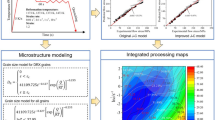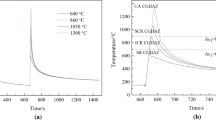Abstract
The effects of technological parameters such as pre-deformation, strain rate, and final forming temperature on the formability of high-strength steel 22MnB5 were studied. Firstly, the finite element model of thermal-mechanical-fluid coupling was established by finite element simulation software ABAQUS. Secondly, the simulation and experiment of the pure hydraulic bulging with the forming temperature are 20, 100, 300, 500, and 700 °C and were carried out, respectively. Finally, by setting the technological parameters such as the cavity pressure loading rate (2, 4, 6, 8, and10 MPa/s) and final forming temperature T (20, 100, 300, 500, and 700 °C), the numerical simulation and the experiment of the coupling of the initial room temperature pre-deformation and high-temperature final forming were studied, and the optimal combination of process parameters was optimized by making the bulging height as the objective function at the end of the forming process. Keeping the cavity pressure loading rate is invariable; the bulging height difference between the two processes is 12.02, 20.43, 26.18, 33.20, and 39.39 mm, respectively, when the temperature is 300 °C. Keeping the final forming temperature is invariable; when the cavity pressure loading rate is 8 MPa/s and the temperature is 300 °C, the difference of the bulging height difference between the hot hydraulic bulging and room temperature hydraulic bulging is maximum, the largest value is 2.17 mm. Taking the bulging height as the criteria of material forming performance, the combination of the final forming temperature of 300 °C and the cavity pressure loading rate of 8 MPa/s is optimum. Finally, the whole coupling process is divided into three stages, and by using the form of structuring sectionalized constitutive equation, the influence law of the dual action of work hardening and softening on the deformation and fluidity of the material in the compound-forming process is analyzed from the perspective of the evolution law of microstructure.















Similar content being viewed by others
References
Sun ZY, Lang LH, Wang Y, Zhang QD (2016) Study on the mechanism and the suppression method of wrinkling inside wall using hydroforming of the fairing. Int J Adv Manuf Technol 90(9–12):2527–2535
Zhang QD, Lang LH, Wang Y, Sun ZY (2016) Theoretical investigation on the springback behavior of AA7B04 sheet in hydraulic bulge process. Int J Adv Manuf Technol 87:2861–2871
Hama T, Kojima K, Nishimura Y (2014) Variation of lubrication condition during sheet hydroforming. Procedia Eng 81:1029–1034
Li K (2016) Research on sheet hydroforming application for ships of functional stamping parts. Beihang Univeresity, Beijing
Lang LH, Li T, Zhou XB (2007) The effect of the key process parameters in the innovative hydroforming on the formed parts. J Mater Process Technol 187-188:304–308
Lang LH, Li T, Zhou XB (2006) Optimized constitutive equation of material property based on inverse modeling for aluminum alloy hydroforming simulation. Trans Nonferrous Metals Soc China 16(6):1379–1385
Lang LH, Danckert J, Nielsen KB (2005) Multi-layer sheet hydroforming: experimental and numerical investigation into the very thin layer in the middle. J Mater Process Technol 170(3):524–535
Mohamed S, Foster AD (2012) Investigation of deformation and failure features of AA6082: experimentation and modelling. Int J Mach Tool Manu 53(1):27–38
El Fakir O, Wang L, Balint D (2014) Numerical study of the solution heat treatment, forming, and in-die quenching (HFQ) process on AA5754. Int J Mach Tools Manuf 87:39–48
Wang L, Strangwood M, Balint D (2011) Formability and failure mechanisms of AA2024 under hot forming conditions. Mater Sci Eng A 528(6):2648–2656
Xiao WC (2018) Study of unified viscoplastic constitutive modeling and key technologies of hot stamping of 7075 aluminum sheet. University of Science and Technology Beijing, Beijing
Liu BS, Lang LH, Li HL (2011) Review on methods of constitutive modeling in warm/hot hydroforming. J Plast Engineering 18(3):53–60
Lang LH, Cai GC, Liu KN (2011) Numerical simulation analysis of warm hydroforming process for special aluminum-alloy part. Forging & Stamping Technology 36(6):129–132
So H, Fasmannb D, Hoffmann H (2012) An investigation of the blanking process of the quenchable boron alloyed steel 22MnB5 before and after hot stamping process. J Mater Process Technol 212(2):437–449
Luo K (2017) Simulation study on hot stamping of B-pillar reinforced plate. Yanshan University, Hebei
Yu HQ, Chen JD (2001) Principle of metal plastic forming. China Machine Press, Beijing
Liu BS (2012) Research on forming mechanism and key technologies of warm sheet hydroforming. Beihang University, Beijing
Gong QJ, Yang M, Liang YL (2018) Hot formability and dynamic recrystallization behavior of new high performance aluminum alloy 211Z-X. Chin J Rare Metal 42(1):36–44
Huang S, Wang L, Zhang BJ (2015) Hot deformation behavior and microstructure evolution of GH4706 alloy. J Mater Eng 43(2):41–46
Swift HW (1952) Plastic instability under plane stress. J Mech Phys Solids 1(1):1–18
Fields DS, Backofen WA (1957) Determination of strain hardening chareacteristics by torsion testing. Proceedings American Society Testing Materials 57:1259–1272
Sellars CM, Tegart (1966) On the mechanism of deformation. Aeta Metallurgiea 14:1136–1138
Garofalo F, Richmond O, Domis WF (1963) Strain time, rate stress and rate temperature relationships during large deformations in creep. Proc Inst Mech Eng Conf Proc London:31–39A
Funding
The authors gratefully acknowledge the financial support from the National Science and Technology Major Project with Grant No.2018ZX04044001.
Author information
Authors and Affiliations
Corresponding author
Additional information
Publisher’s note
Springer Nature remains neutral with regard to jurisdictional claims in published maps and institutional affiliations.
Rights and permissions
About this article
Cite this article
Shan, Z., Sun, F., Zhang, Q. et al. Research on the plastic fluidity of high-strength steel 22MnB5 based on the thermal-mechanical-fluid multi-filed coupling. Int J Adv Manuf Technol 107, 259–270 (2020). https://doi.org/10.1007/s00170-020-05007-4
Received:
Accepted:
Published:
Issue Date:
DOI: https://doi.org/10.1007/s00170-020-05007-4




